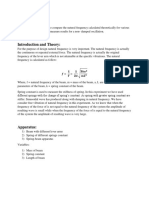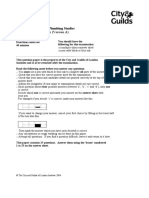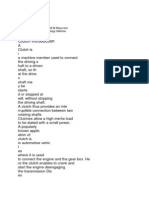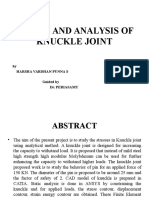Drag Force
Drag Force
Uploaded by
Imran BahaCopyright:
Available Formats
Drag Force
Drag Force
Uploaded by
Imran BahaCopyright
Available Formats
Share this document
Did you find this document useful?
Is this content inappropriate?
Copyright:
Available Formats
Drag Force
Drag Force
Uploaded by
Imran BahaCopyright:
Available Formats
TITLE: Drag force on a golf ball OBJECTIVE: To obtain the drag coefficient with variety of velocity in the test
est section (wind tunnel) for golf ball To make comparison between the drag force produces by golf ball with smooth surface and rough surface To study the type of boundary layer that occurred when approaching a golf ball with the difference surfaces
INTRODUCTION:
Adapted from www.grc.nasa.gov
Drag is the aerodynamic force that opposes an aircraft's motion through the air. Drag is generated by every part of the airplane (even the engines!). How is drag generated? For drag to be generated, the solid body must be in contact with the fluid. If there is no fluid, there is no drag. Drag is generated by the difference in velocity between the solid object and the fluid. There must be motion between the object and the fluid. If there is no motion, there is no drag. It makes no difference whether the object moves through a static fluid or whether the fluid moves past a static solid object. In fluid dynamics, drag (sometimes called fluid resistance) is the force that resists the movement of a solid object through a fluid (a liquid or gas). The most familiar form of drag is made up of friction forces, which act parallel to the object's surface, plus pressure forces, which act in a direction perpendicular to the object's surface. For a solid object moving through a fluid, the drag is the component of the net aerodynamic or hydrodynamic force acting in the direction
of the movement. The component perpendicular to this direction is considered lift. Therefore drag acts to oppose the motion of the object, and in a powered vehicle it is overcome by thrust.Drag is a force and is therefore a vector quantity having both a magnitude and a direction. Drag acts in a direction that is opposite to the motion of the aircraft.
An object moving through a gas or liquid experiences a force in direction opposite to its motion. Terminal velocity is achieved when the drag force is equal in magnitude but opposite in direction to the force propelling the object. Shown is a sphere (like a golf ball) in Stokes flow, at very low Reynolds number. Adapted from www.wikipedia.org
In astro dynamics, depending on the situation, atmospheric drag can be regarded as inefficiency requiring expense of additional energy during launch of the space object or as a bonus simplifying return from orbit. Types of drag are generally divided into three categories: Parasitic drag Lift-induced drag Wave drag
Parasitic drag includes form drag, skin friction, and interference drag. Liftinduced drag is only relevant when wings or a lifting body are present, and is therefore usually discussed either in the aviation perspective of drag, or in the design of either semi-planning or planning hulls. Wave drag occurs when a solid object is moving through a fluid at or near the speed of sound in that fluid. The overall drag of an object is characterized by a dimensionless number called the drag coefficient, and is calculated using the drag equation. Assuming a constant drag coefficient, drag will vary as the square of velocity. Thus, the resultant power needed to overcome this drag will vary as the cube of velocity. The standard equation for drag is one half the coefficient of drag multiplied by the fluid mass density, the cross sectional area of the specified item, and the square of the velocity. Wind resistance is a layman's term used to describe drag. Its use is often vague, and is usually used in a relative sense (e.g., A badminton shuttlecock has more wind resistance than a squash ball).
THEORY: Drag is the component of force on a body acting parallel to the direction of relative motion. The drag force, FD, was written in the functional form FD = f1 (d, V, , ). Application of the Buckingham Pi theorem resulted in two dimensionless parameters that written in function form as
FD 1 V 2 d 2 2
Vd = f2
(1.0)
Note that d2 is proportional to the cross-sectional area (A = d2/4) and therefore we could write
Vd = f3 = f 3 (Re) 1 2 V A 2 FD
(1.1)
Although Eq. 1.1 was obtained for sphere, the form of equation is valid for incompressible flow over anybody; the characteristic length used in the Reynolds Number depends on body shape.
The drag coefficient, CD, anybody defined as: (1.2)
APPARATUS: Subsonic wind tunnel Golf balls (rough and smooth surface)
Subsonic wind tunnel
Golf ball at testing area
PROCEDURE: 1. The apparatus has been setup and the rigid rod has been put in the wind tunnel. 2. The wind tunnel was made sure to be sealed by using duct tape. 3. The wind tunnel was switched on, and the velocity was increased to 8 m/s. 4. The weight on the stabilizer was balanced. 5. The force due the impact of the moving air was measured. 6. Step 4 was repeated by using increments of 2 m/s until the velocity reaches 20 m/s. 7. The above steps were repeated by using a low dimple and high dimple golf ball by attaching the golf ball to the rigid rod. Then, each data has been taken.
RESULTS:
Diameter of golf ball = 0.04265m
Rough Surface (400 dimple)
No
Velocity (m/s)
Reynolds Number
Rigid Rod Drag Force, FD (N)
Drag Force, FD (N)
Net Drag Force, FD (N)
Drag Coefficient, CD
1 2 3 4 5 6 7
8 10 12 14 16 18 20
22996 28745 34494 40243 45992 51741 57489
0.03 0.045 0.055 0.07 0.085 0.11 0.14
0.045 0.08 0.095 0.12 0.145 0.175 0.21
0.015 0.035 0.04 0.05 0.06 0.065 0.07
0.2095 0.3129 0.2483 0.2280 0.2095 0.1793 0.1564
Smooth Surface (200 dimple)
No
Velocity (m/s)
Reynolds Number
Rigid Rod Drag Force, FD (N)
Drag Force, FD (N)
Net Drag Force, FD (N)
Drag Coefficient, CD
1 2 3 4 5 6
8 10 12 14 16 18
22996 28745 34494 40243 45992 51741
0.03 0.045 0.055 0.07 0.085 0.11
0.06 0.09 0.105 0.125 0.15 0.185
0.03 0.045 0.05 0.055 0.065 0.075
0.419 0.4023 0.3104 0.2508 0.227 0.2069
20
57489
0.14
0.22
0.08
0.1788
SAMPLE CALCULATION
air air Diameter of Ball
= 1.23 kg/m3 = 1.825 x 10-5 Pa.s = 0.04265m
1. To calculate Reynold Number, Re
Re
28745
2. To calculate Drag Coefficient, CD
CD
0.4023
DISCUSSION CONCLUSION REFERENCES
Fluid Mechanics - Fundamentals and Applications 4th Edition; Yunus A. engel and John M. Cimbala Published by Mc Graw Hill International Edition 2006
http://www.see.ed.ac.uk/~johnc/teaching/fluidmechanics4/200304/fluids10/integral.html
Advances In Fluid Mechanics Laminar and Turbulent Boundary Layer M. Rahman - Computational Mechanics Publications.
Engineering Fluid Mechanics Sixth Edition John A. Roberson, Clayton T. Crowe John Wiley & Sons. inc. Mechanical Engineering Series Laminar Viscous Flow V. N. Constantinescu Springer. Introduction To fluid Mechanics And Fluid Machines Second Edition S K Som & G Biswas Tata McGraw Hill. www.aerospaceweb.org www.nasa.org
You might also like
- Ansys Report of Knuckle JointDocument27 pagesAnsys Report of Knuckle JointNíthìsh GøwdåNo ratings yet
- Mech Lab Spring1Document5 pagesMech Lab Spring1TalhaNo ratings yet
- Torque Arm Shape OptimizationDocument8 pagesTorque Arm Shape OptimizationJay MalaneyNo ratings yet
- Applied Fluid Mechanics - 17 Drag and LiftDocument23 pagesApplied Fluid Mechanics - 17 Drag and LiftShivaun SeecharanNo ratings yet
- 2 - 3 PfeffermannDocument17 pages2 - 3 PfeffermannDHARMENDRANo ratings yet
- The Use of Silicone Materials in Close Proximity PDFDocument4 pagesThe Use of Silicone Materials in Close Proximity PDFLBNo ratings yet
- 6129-202 Key Plumbing Principles Version ADocument10 pages6129-202 Key Plumbing Principles Version AP_DaviesNo ratings yet
- Types of Drag On AircraftDocument20 pagesTypes of Drag On AircraftPramod DhaigudeNo ratings yet
- Chain Drives PPTFDocument44 pagesChain Drives PPTFMadhuNo ratings yet
- Design of Machine ElementDocument30 pagesDesign of Machine ElementVigneswaran K100% (1)
- Lab 1Document8 pagesLab 1Mansoob BukhariNo ratings yet
- Aerodynamic Analysis of Motion of Two Vehicles and Their Influence On Drag Coefficient.Document3 pagesAerodynamic Analysis of Motion of Two Vehicles and Their Influence On Drag Coefficient.Innovative Research PublicationsNo ratings yet
- Internal Heat ExchangerDocument39 pagesInternal Heat ExchangerNeal Christian ParatoNo ratings yet
- 15ME3112 Design of Machine ElementsDocument29 pages15ME3112 Design of Machine Elementslikhith saiNo ratings yet
- Machine Design Practice July 2019 Assignment IIT MadrasDocument39 pagesMachine Design Practice July 2019 Assignment IIT MadrasVishwajit HegdeNo ratings yet
- Knuckle Joints DesignDocument10 pagesKnuckle Joints DesignKvrd Prasad100% (1)
- Me6503 Dme Unit 2 Study Notes 2015Document27 pagesMe6503 Dme Unit 2 Study Notes 2015Bala MuruganNo ratings yet
- Machine Drawing With CAD - Ning (PDFDrive)Document227 pagesMachine Drawing With CAD - Ning (PDFDrive)Anurag JayasNo ratings yet
- Files-5-Exams Quizzes Examples Problems Me315Document44 pagesFiles-5-Exams Quizzes Examples Problems Me315AndrestorpNo ratings yet
- Six-Bar Chains:: Six-Bar Linkage Type With Seven Revolute Joints For More PerformanceDocument12 pagesSix-Bar Chains:: Six-Bar Linkage Type With Seven Revolute Joints For More PerformanceAsaduz ZamanNo ratings yet
- Air Craft Over Head Bin - ReportDocument5 pagesAir Craft Over Head Bin - ReportUma T ViswanathanNo ratings yet
- Adaptive Design of Machine Tool GearboxesDocument9 pagesAdaptive Design of Machine Tool Gearboxesأحمد دعبسNo ratings yet
- Camd Lab ManualDocument95 pagesCamd Lab ManualK.S.HARIHARANNo ratings yet
- 2-Lectures LEC 19 Modifications of The Mohr Theory For Brittle MaterialsDocument41 pages2-Lectures LEC 19 Modifications of The Mohr Theory For Brittle MaterialsNagaraj RamachandrappaNo ratings yet
- ED7111Document117 pagesED7111palaniappan_pandianNo ratings yet
- Advanced Kinematics and Dynamics of MachineryDocument8 pagesAdvanced Kinematics and Dynamics of MachineryIbmWasuserNo ratings yet
- Metalwork: University of Cambridge International Examinations General Certificate of Education Ordinary LevelDocument12 pagesMetalwork: University of Cambridge International Examinations General Certificate of Education Ordinary Levelmstudy123456No ratings yet
- MT 8711 Cad Lab Univ QP Set 1Document9 pagesMT 8711 Cad Lab Univ QP Set 1Gopinath NNo ratings yet
- Design Optimization and Analysis of Leaf Spring Using Static Load ConditionsDocument7 pagesDesign Optimization and Analysis of Leaf Spring Using Static Load Conditionshariram palanisamyNo ratings yet
- Mos Lab Manual PDFDocument34 pagesMos Lab Manual PDFs.rihanaNo ratings yet
- Case 3.6Document49 pagesCase 3.6Mohammad Zaki UsmanNo ratings yet
- Rolling Contact BearingsDocument11 pagesRolling Contact BearingsritNo ratings yet
- Test Facilities Iit MadrasDocument18 pagesTest Facilities Iit MadrasM.Saravana Kumar..M.ENo ratings yet
- DOM Full Notes PDFDocument263 pagesDOM Full Notes PDFCHAMAN R100% (1)
- Design of Power ScrewDocument18 pagesDesign of Power Screwvaibhav kuchekarNo ratings yet
- Example 02 (Linstatic Angle-Ply)Document7 pagesExample 02 (Linstatic Angle-Ply)Luis Huayaney100% (1)
- Engineering Graphics: Unit - 1 IntroductionDocument17 pagesEngineering Graphics: Unit - 1 IntroductionShubham SharmaNo ratings yet
- Lab ManualDocument84 pagesLab ManualSai KumarNo ratings yet
- Camd Lab Manual17Document50 pagesCamd Lab Manual17Kavi ArasuNo ratings yet
- C-D Nozzle PDFDocument38 pagesC-D Nozzle PDFAnonymous VKv75qe98No ratings yet
- 1 DesignDocument54 pages1 DesignDr. Aung Ko LattNo ratings yet
- Design and Analysis of PROTECTED FLANGE COUPLING Solidworks 2016 and ANSYS WorkbenchDocument27 pagesDesign and Analysis of PROTECTED FLANGE COUPLING Solidworks 2016 and ANSYS Workbenchamu100% (1)
- Shaft Exercises Problem No. 1-2Document3 pagesShaft Exercises Problem No. 1-2Ariel GamboaNo ratings yet
- Machine Design IIDocument23 pagesMachine Design IIBinar Arum OktaviaNo ratings yet
- Computer Aided Machine Drawing Laboratory: Lab ManualDocument31 pagesComputer Aided Machine Drawing Laboratory: Lab ManualGiridharadhayalanNo ratings yet
- Lecture 6 Design of The Crankshaft: ResearchDocument22 pagesLecture 6 Design of The Crankshaft: Researchsujay nayak0% (1)
- Chapter 12 SolutionsDocument27 pagesChapter 12 Solutionsantant30520% (1)
- Key and Coupling Solutions PDFDocument22 pagesKey and Coupling Solutions PDFAlexander Pernia Diaz100% (1)
- Cama Lab1Document63 pagesCama Lab1pachieduNo ratings yet
- MMD Lecture Notes PDFDocument133 pagesMMD Lecture Notes PDFMukund singhNo ratings yet
- Design and Analysis of Composite Drive ShaftDocument8 pagesDesign and Analysis of Composite Drive Shaftmesfin DemiseNo ratings yet
- MP Lab Manual 2015Document107 pagesMP Lab Manual 2015PranoveNo ratings yet
- Spur Gears - SlidesDocument45 pagesSpur Gears - SlidesKim Jeff BeringuelNo ratings yet
- NIT Rourkela: Title: Machine Drawing & Solid Modelling Sheet: 1 Fig: 2.1 Material: SS304Document3 pagesNIT Rourkela: Title: Machine Drawing & Solid Modelling Sheet: 1 Fig: 2.1 Material: SS304MD TARIQUL ISLAM MUNNANo ratings yet
- ACD Lab Manual Spur Gear DesignDocument4 pagesACD Lab Manual Spur Gear Designbalaguru780% (1)
- Design and Analysis of Knuckle JointDocument25 pagesDesign and Analysis of Knuckle JointSapari Vel33% (3)
- Design Lab (18MEL77) Updated ManualDocument57 pagesDesign Lab (18MEL77) Updated ManualSagar SagNo ratings yet
- Helical Gears: DefinitionDocument29 pagesHelical Gears: DefinitionMuthuvel MNo ratings yet
- Me 8462-Mt-II Lab ManualDocument39 pagesMe 8462-Mt-II Lab ManualK.S.HARIHARAN100% (1)
- Drilling MachineDocument87 pagesDrilling MachineRamesh Panda50% (4)
- Theory DragDocument3 pagesTheory DragNur' AyuniNo ratings yet
- Drag Force Full ReportDocument29 pagesDrag Force Full ReportAbdul RahmanNo ratings yet
- Chapter-9-Drag and Lift, Water HammerDocument23 pagesChapter-9-Drag and Lift, Water HammerElla Mae AtienzaNo ratings yet
- Variable Geometry Turbocharger Technologies For Exhaust Energy Recovery and Boosting A ReviewDocument17 pagesVariable Geometry Turbocharger Technologies For Exhaust Energy Recovery and Boosting A ReviewMomen Al-Himony100% (1)
- Kingston Model 115: Kingston Safety & Relief ValvesDocument2 pagesKingston Model 115: Kingston Safety & Relief ValvesAntonio Serrano100% (1)
- ARC-Torrex-120D-150D - Manual - X Ray Inspection UnitDocument5 pagesARC-Torrex-120D-150D - Manual - X Ray Inspection UnitullwnNo ratings yet
- ERP Comm Line WII Lematang Add WakatekDocument1 pageERP Comm Line WII Lematang Add WakatekAcunNo ratings yet
- Shipboard High VoltageDocument62 pagesShipboard High VoltageArun S100% (1)
- Advanced Pattern Cumulative Test-3 (Act-3) : Paper-2Document31 pagesAdvanced Pattern Cumulative Test-3 (Act-3) : Paper-2Tushar Kant0% (1)
- Technology Licensing/ Patent Acquisition Opportunity - US 6,294,900 - Bi-Directional AC or DC Voltage RegulatorDocument25 pagesTechnology Licensing/ Patent Acquisition Opportunity - US 6,294,900 - Bi-Directional AC or DC Voltage RegulatorMayur BundelNo ratings yet
- Introduction To SemiconductorDocument37 pagesIntroduction To SemiconductorWendell NiveraNo ratings yet
- Ferromagnetic PDFDocument2 pagesFerromagnetic PDFHeron100% (1)
- Dietarymanagementof Obesity: Cornerstones of Healthy Eating PatternsDocument18 pagesDietarymanagementof Obesity: Cornerstones of Healthy Eating PatternsLeonardoNo ratings yet
- Lecture 3 - Heat Conduction EquationDocument25 pagesLecture 3 - Heat Conduction Equationnatnaelzelalem03No ratings yet
- Manual Bateria Gil 7641-20Document36 pagesManual Bateria Gil 7641-20K'bo KevinNo ratings yet
- Positioning Wxford For The UpturnDocument114 pagesPositioning Wxford For The UpturnJoe SchmoeldNo ratings yet
- LIT Sullair Cycling Refrigerated Dryer Brochure - SAPATREFCY201901 1 - ENDocument9 pagesLIT Sullair Cycling Refrigerated Dryer Brochure - SAPATREFCY201901 1 - ENAdmin RidarNo ratings yet
- Electric Motor CouplingDocument16 pagesElectric Motor CouplingkhairullabdullahNo ratings yet
- Makita Service NoteDocument3 pagesMakita Service NoteMarcin LosyNo ratings yet
- Vantage: Installation and Operating InstructionsDocument2 pagesVantage: Installation and Operating InstructionsAngel Quijano ArmengolNo ratings yet
- Pre 210414Document66 pagesPre 210414Israel López LagosNo ratings yet
- Background of The Study (PROJECT PROPOSAL) - 11Document2 pagesBackground of The Study (PROJECT PROPOSAL) - 11Alyssum MarieNo ratings yet
- Fuel Furnace and Refractories Lab Manual: (For B.Tech in Metallurgical and Materials Engg.)Document18 pagesFuel Furnace and Refractories Lab Manual: (For B.Tech in Metallurgical and Materials Engg.)john powerNo ratings yet
- 12th Physics 1 Mark Classification Questions English Medium PDF DownloadDocument43 pages12th Physics 1 Mark Classification Questions English Medium PDF Downloadkesavanskesavans757No ratings yet
- Introduction To MOS TechnologiesDocument15 pagesIntroduction To MOS TechnologieslokeshwarrvrjcNo ratings yet
- LMF - EN Version 21.4Document46 pagesLMF - EN Version 21.4fatbanumarfadiNo ratings yet
- Topic 2 Diodes: "An Investment in Knowledge Pays The Best Interest." Benjamin FranklinDocument9 pagesTopic 2 Diodes: "An Investment in Knowledge Pays The Best Interest." Benjamin FranklinEnitsuj Eam EugarbalNo ratings yet
- Excavation Equipment: Shovel Excavation Equipment: ShovelDocument34 pagesExcavation Equipment: Shovel Excavation Equipment: ShovelJazib AyazNo ratings yet
- Ambient Crude Oil StorageDocument13 pagesAmbient Crude Oil StoragesachinumaryeNo ratings yet
























































































